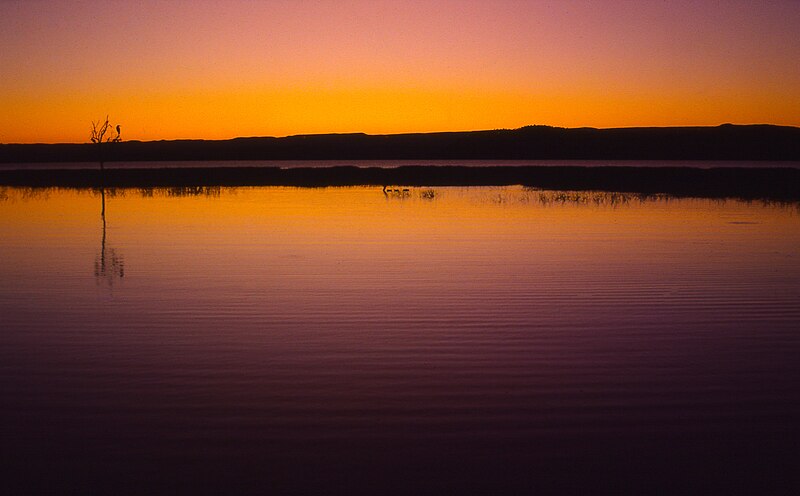File:Early Morning at Lake Baringo, Rift Valley, Kenya (34004528696).jpg

Original file (2,000 × 1,240 pixels, file size: 1.73 MB, MIME type: image/jpeg)
Captions
Captions
Summary edit
| DescriptionEarly Morning at Lake Baringo, Rift Valley, Kenya (34004528696).jpg |
PUBLISHED: <a href="https://takemeback.to/geo/year/1987/kenya#.XLP8LS97GS5" rel="noreferrer nofollow">takemeback.to/geo/year/1987/kenya#.XLP8LS97GS5</a> Lake Baringo is, after Lake Turkana, the most northern of the Kenyan Rift Valley lakes, with a surface area of about 130 square kilometres (50 sq mi) and an elevation of about 970 metres (3,180 ft). The lake is fed by several rivers, Molo, Perkerra and Ol Arabel, and has no obvious outlet; the waters are assumed to seep through lake sediments into the faulted volcanic bedrock. It is one of the two freshwater lakes in the Rift Valley in Kenya, the other being Lake Naivasha. It lies off the beaten track in a hot and dusty setting and over 470 species of birds have been recorded there, occasionally including migrating flamingos. A Goliath heronry is located on a rocky islet in the lake known as Gibraltar. The lake is part of the East African Rift system. The Tugen Hills, an uplifted fault block of volcanic and metamorphic rocks, lies west of the lake. The Laikipia Escarpment lies to the east. Water flows into the lake from the Mau Hills and Tugen Hills. It is a critical habitat and refuge for more than 500 species of birds and fauna, some of the migratory waterbird species being significant regionally and globally. The lake also provides an invaluable habitat for seven fresh water fish species. One, Oreochromis niloticus baringoensis (a Nile tilapia subspecies), is endemic to the lake. Lake fishing is important to local social and economic development. Additionally the area is a habitat for many species of animals including the hippopotamus (Hippopotamus amphibius), Nile crocodile (Crocodylus niloticus) and many other mammals, amphibians, reptiles and the invertebrate communities. While stocks of Nile tilapia in the lake are now low, the decline of this species has been mirrored by the success of another, the marbled lungfish (Protopterus aethiopicus) which was introduced to the lake in 1974 and which now provides the majority of fish output from the lake. Water levels have been reduced by droughts and over-irrigation. The lake is commonly turbid with sediment, partly due to intense soil erosion in the catchment, especially on the Loboi Plain south of the lake. The lake has several small islands, the largest being Ol Kokwe Island. Ol Kokwe, an extinct volcanic centre related to Korosi volcano north of the lake, has several hot springs and fumaroles, some of which have precipitated sulfur deposits. A group of hot springs discharge along the shoreline at Soro near the northeastern corner of the island. Several important archaeological and palaeontological sites, some of which have yielded fossil hominoids and hominins, are present in the Miocene to Pleistocene sedimentary sequences of the Tugen Hills.[ The journey to Lake Baringo was famously noted to be "... a genuine pain in the ass" by Jimmy Stewart in a poem read on the Tonight Show with Johnny Carson.
|
| Date | |
| Source | Early Morning at Lake Baringo, Rift Valley, Kenya |
| Author | Ray in Manila |
Licensing edit
- You are free:
- to share – to copy, distribute and transmit the work
- to remix – to adapt the work
- Under the following conditions:
- attribution – You must give appropriate credit, provide a link to the license, and indicate if changes were made. You may do so in any reasonable manner, but not in any way that suggests the licensor endorses you or your use.
| This image was originally posted to Flickr by Ray in Manila at https://flickr.com/photos/21186555@N07/34004528696 (archive). It was reviewed on 6 August 2019 by FlickreviewR 2 and was confirmed to be licensed under the terms of the cc-by-2.0. |
6 August 2019
File history
Click on a date/time to view the file as it appeared at that time.
| Date/Time | Thumbnail | Dimensions | User | Comment | |
|---|---|---|---|---|---|
| current | 09:04, 6 August 2019 |  | 2,000 × 1,240 (1.73 MB) | Rudolphous (talk | contribs) | Transferred from Flickr via #flickr2commons |
You cannot overwrite this file.
File usage on Commons
There are no pages that use this file.
File usage on other wikis
The following other wikis use this file:
- Usage on www.wikidata.org
Metadata
This file contains additional information such as Exif metadata which may have been added by the digital camera, scanner, or software program used to create or digitize it. If the file has been modified from its original state, some details such as the timestamp may not fully reflect those of the original file. The timestamp is only as accurate as the clock in the camera, and it may be completely wrong.
| Date and time of data generation | 04:35, 5 March 1987 |
|---|---|
| Horizontal resolution | 300 dpi |
| Vertical resolution | 300 dpi |
| Software used | Adobe Photoshop Lightroom 6.4 (Macintosh) |
| File change date and time | 14:26, 15 April 2017 |
| Exif version | 2.31 |
| Date and time of digitizing | 20:35, 4 March 2009 |
| Color space | sRGB |
| Date metadata was last modified | 22:26, 15 April 2017 |
| Rating (out of 5) | 4 |
| Unique ID of original document | uuid:052B37F2B808DE119DDB889D8BF83509 |
| Keywords |
|
| IIM version | 4 |